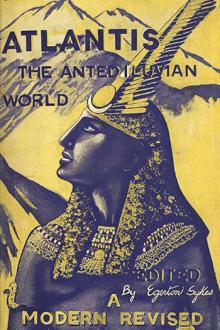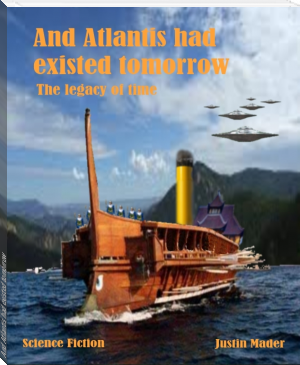Atlantis: The Antedeluvian World by Ignatius Donnelly (thriller novels to read .TXT) 📕

- Author: Ignatius Donnelly
- Performer: -
Book online «Atlantis: The Antedeluvian World by Ignatius Donnelly (thriller novels to read .TXT) 📕». Author Ignatius Donnelly
It seems to me certain the above are simply two versions of the same event; that while ships from Atlantis carried terrified passengers to tell the story of the dreadful catastrophe to the people of the Mediterranean shores, other ships, flying from the tempest, bore similar awful tidings to the civilized races around the Gulf of Mexico.
The native Mexican historian, Ixtlilxochitl, gave this as the Toltec legend of the Flood:
It is found in the histories of the Toltecs that this age and first world, as they call it, lasted 1716 years; that men were destroyed by tremendous rains and lightning from the sky, and even all the land, without the exception of anything, and the highest mountains, were covered up and submerged in water fifteen cubits (caxtolmolatli); and here they added other fables of how men came to multiply from the few who escaped from this destruction in a “toptlipetlocali;” that this word nearly signifies a close chest; and how, after men had multiplied, they erected a very high “zacuali,” which is to-day a tower of great height, in order to take refuge in it should the second world (age) be destroyed. Presently their languages were confused, and, not being able to understand each other, they went to different parts of the earth.
“The Toltecs, consisting of seven friends, with their wives, who understood the same language, came to these parts, having first passed great land and seas, having lived in caves, and having endured great hardships in order to reach this land; . . . they wandered 104 years through different parts of the world before they reached Hue Hue Tlapalan, which was in Ce Tecpatl, 520 years after the Flood.”
(“Ixtlilxochitl Relaciones,” in Kingsborough’s “Mex. Ant.,” vol. ix., pp. 321, 322.)
It will of course be said that this account, in those particulars where it agrees with the Bible, was derived from the teachings of the Spanish priests; but it must be remembered that Ixtlilxochitl was an Indian, a native of Tezeuco, a son of the queen, and that his “Relaciones” were drawn from the archives of his family and the ancient writings of his nation: he had no motive to falsify documents that were probably in the hands of hundreds at that time.
Here we see that the depth of the water over the earth, “fifteen cubits,” given in the Toltec legend, is precisely the same as that named in the Bible: “fifteen cubits upward did the waters prevail.” (Gen., chap. vii., 20.)
In the two curious picture-histories of the Aztecs preserved in the Boturini collection, and published by Gamelli Careri and others, there is a record of their migrations from their original location through various parts of the North American continent until their arrival in Mexico. In both cases their starting-point is an island, from which they pass in a boat; and the island contains in one case a mountain, and in the other a high temple in the midst thereof. These things seem to be reminiscences of their origin in Atlantis.
In each case we see the crooked mountain of the Aztec legends, the Calhuacan, looking not unlike the bent mountain of the monk, Cosmos.
In the legends of the Chibchas of Bogota we seem to have distinct reminiscences of Atlantis. Bochica was their leading divinity. During two thousand years he employed himself in elevating his subjects. He lived in the sun, while his wife Chia occupied the moon. This would appear to be an allusion to the worship of the sun and moon. Beneath Bochica in their mythology was Chibchacum. In an angry mood he brought a deluge on the people of the table-land. Bochica punished him for this act, and obliged him ever after, like Atlas, to bear the burden of the earth on his back. Occasionally be shifts the earth from one shoulder to another, and this causes earthquakes!
Here we have allusions to an ancient people who, during thousands of years, were elevated in the scale of civilization, and were destroyed by a deluge; and with this is associated an Atlantean god bearing the world on his back. We find even the rainbow appearing in connection with this legend. When Bochica appeared in answer to prayer to quell the deluge he is seated on a rainbow. He opened a breach in the earth at Tequendama, through which the waters of the flood escaped, precisely as we have seen them disappearing through the crevice in the earth near Bambyce, in Greece.
The Toltecs traced their migrations back to a starting-point called “Aztlan,” or “Atlan.” This could be no other than, Atlantis. (Bancroft’s “Native Races,” vol. v., p. 221.) “The original home of the Nahuatlacas was Aztlan, the location of which has been the subject of much discussion. The causes that led to their exodus from that country can only be conjectured; but they may be supposed to have been driven out by their enemies, for Aztlan is described as a land too fair and beautiful to be left willingly in the mere hope of finding a better.” (Bancroft’s “Native Races,” vol. v., p. .306.) The Aztecs also claimed to have come originally from Aztlan. (Ibid., p. 321.) Their very name, Aztecs, was derived from Aztlan. (Ibid., vol. ii., p. 125). They were Atlanteans.
The “Popul Vuh” tells us that after the migration from Aztlan three sons of the King of the Quiches, upon the death of their father, “determined to go as their fathers had ordered to the East, on the shores of the sea whence their fathers had come, to receive the royalty, ‘bidding adieu to their brothers and friends, and promising to return.’ Doubtless they passed over the sea when they went to the East to receive the royalty.
Now this is the name of the lord, of the monarch of the people of the East where they went. And when they arrived before the lord Nacxit, the name of the great lord, the only judge, whose power was without limit, behold he granted them the sign of royalty and all that represents it .
. . and the insignia of royalty . . . all the things, in fact, which they brought on their return, and which they went to receive from the other side of the sea—the art of painting from Tulan, a system of writing, they said, for the things recorded in their histories.”
(Bancroft’s “Native Races,” vol. v., p. 553 “Popul Vuh,” p. 294.) This legend not only points to the East as the place of origin of these races, but also proves that this land of the East, this Aztlan, this Atlantis, exercised dominion over the colonies in Central America, and furnished them with the essentials of civilization. How completely does this agree with the statement of Plato that the kings of Atlantis held dominion over parts of “the great opposite continent!”
Professor Valentini (“Maya Archæol.,” p. 23) describes an Aztec picture in the work of Gemelli (“Il giro del mondo,” vol. vi.) of the migration of the Aztecs from Aztlan:
“Out of a sheet of water there projects the peak of a mountain; on it stands a tree, and on the tree a bird spreads its .wings. At the foot of the mountain-peak there comes out of the water the heads of a man and a woman. The one wears on his head the symbol of his name, Coxcox, a pheasant. The other head bears that of a hand with a bouquet (xochitl, a flower, and quetzal, shining in green gold). In the foreground is a boat, out of which a naked man stretches out his hand imploringly to heaven. Now turn to the sculpture in the Flood tablet (on the great Calendar stone). There you will find represented the Flood, and with great emphasis, by the accumulation of all those symbols with which the ancient Mexicans conveyed the idea of water: a tub of standing water, drops springing out—not two, as heretofore in the symbol for Atl, water—but four drops; the picture for moisture, a snail; above, a crocodile, the king of the rivers. In the midst of these symbols you notice the profile of a man with a fillet, and a smaller one of a woman.
There can be doubt these are the Mexican Noah, Coxcox, and his wife, Xochiquetzal; and at the same time it is evident (the Calendar stone, we know, was made in A.D., 1478) that the story of them, and the pictures representing the story, have not been invented by the Catholic clergy, but really existed among these nations long before the Conquest.”
The above figure represents the Flood tablet on the great Calendar stone.
When we turn to the uncivilized Indians of America, while we still find legends referring to the Deluge, they are, with one exception, in such garbled and uncouth forms that we can only see glimpses of the truth shining through a mass of fable.
The following tradition was current among the Indians of the Great Lakes: “In former times the father of the Indian tribes dwelt toward the rising sun. Having been warned in a dream that a deluge was coming upon the earth, be built a raft, on which be saved himself, with his family and all the animals. He floated thus for several months. The animals, who at that time spoke, loudly complained and murmured against him. At last a new earth appeared, on which he landed with all the animals, who from that time lost the power of speech, as a punishment for their murmurs against their deliverer.”
According to Father Charlevoix, the tribes of Canada and the valley of the Mississippi relate in their rude legends that all mankind was destroyed by a flood, and that the Good Spirit, to repeople the earth, had changed animals into men. It is to J. S. Kohl we owe our acquaintance with the version of the Chippeways—full of grotesque and perplexing touches—in which the man saved from the Deluge is called Menaboshu. To know if the earth be drying, he sends a bird, the diver, out of his bark; then becomes the restorer of the human race and the founder of existing society.
A clergyman who visited the Indians north-west of the Ohio in 1764 met, at a treaty, a party of Indians from the west of the Mississippi.
“They informed him that one of their most ancient traditions was that, a great while ago, they had a common father, who lived toward the rising of the sun, and governed the whole world; that all the white people’s heads were under his feet; that he had twelve sons, by whom he administered the government; that the twelve sons behaved very bad, and tyrannized over the people, abusing their power; that the Great Spirit, being thus angry with them, suffered the white people to introduce spirituous liquors among them, made them drunk, stole the special gift of the Great Spirit from them, and by this means usurped power over them; and ever since the Indians’ heads were under the white people’s feet.” (Boudinot’s “Star in the West,” p. 111.) Here we note that they looked “toward the rising sun”—toward Atlantis—for the original home of their race; that this region governed “the whole world;” that it contained white people, who were at first a subject race, but who subsequently rebelled, and acquired dominion over the darker races. We will see reason hereafter to conclude that Atlantis had a composite population, and that the





Comments (0)